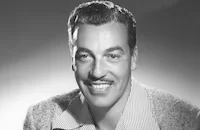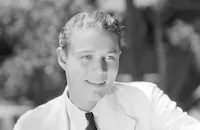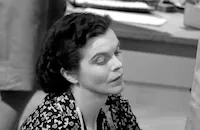Dance Hall
Brief Synopsis
Cast & Crew
Irving Pichel
Carole Landis
Cesar Romero
William Henry
June Storey
J. Edward Bromberg
Film Details
Technical Specs

Synopsis
Arrogant womanizer Duke McKay is the manager of Danceland, a dance hall that features the music of talented pianist Joe Brooks. One evening, Duke is protecting Joe from Moon, an oafish bully, when Lily Brown mistakenly thinks that Duke is picking on Moon. Duke explains the situation then tries to smooth-talk Lily, who is too worldly to fall for his lines. Later that night, Lily is kept awake by a crap game Duke is holding in the hotel room opposite hers. She ends the game by winning all the money, then reveals to Duke that she is Venus, the popular singer who is to start working at Danceland the next evening. The next day, Lily rehearses with Joe, who plays a rhapsody he is writing called "The Giant Swing." After Lily's successful show that night, Duke apologizes for his earlier behavior and offers to take her for a drive in the country. His apparent sincerity wins Lily over, but soon she is furious again when she kisses Duke and he smugly observes that women are all alike. She insists on walking home, and an angry Duke drives off. Max Brandon, a genuinely nice guy, gives Lily a ride home, and she begins seeing him. Duke is jealous of Max, who owns a chain of lingerie stores, and one evening, locks Max in a closet and convinces Lily to allow him to drive her home. They wind up in the country again, but this time Lily steals Duke's car and leaves him stranded after he proposes to her. The next day, Ada, a gold-digging waitress, accepts Joe's proposal when he reveals that he has $2,000. Meanwhile, Lily decides that the only way she can get out of her contract with Danceland is if Joe leaves and the hall goes out of business. She persuades Joe to send his rhapsody to her agent, and although all the band leaders like it, they tell Joe that it must be played by a symphony orchestra. Lily convinces Joe to use the money he has saved to hire an orchestra in New York and play his music himself, but before he leaves, Joe lends all of his money to Duke, who is being threatened because of his gambling debts. When Ada finds that Joe is broke, she marries her boss, Frederick Newmeyer, and when Lily learns of the situation, she castigates Duke for robbing Joe of his chance to make it big. Determined to pay Joe back, Duke fixes a raffle that Danceland is holding so that his pal, Charles "Limpy" Larkin, will win the $2,500 prize. Duke gives Limpy ten percent of the winnnings, then puts Joe on a train to New York after giving him the rest. Ada discovers that the raffle is fixed, and the angry patrons soon have Duke arrested. Lily pays back the raffle money with a loan from Max and bails Duke out of jail. The quarrelsome sweethearts then drive home and bicker about which one of them fell in love first.

Director

Irving Pichel
Cast

Carole Landis

Cesar Romero

William Henry
June Storey

J. Edward Bromberg

Charles Halton
Shimen Ruskin
William Haade
Trudi Marsdon
Russ Clark
Frank Fanning
Perc Launders
Dick French

Dorothy Adams
George Chandler

Ralf Harolde
Eddie Marr
Margaret Brayton
Robert Cornell

Nestor Paiva

Lee Phelps

William B. Davidson
Charles Tannen
Madelein Dorval
Crew
Harold Adamson
Lucien Andriot
Jasper Blystone
Harry Brand
Lewis Creber
Richard Day
Mack Gordon
Herschel
Ethel Hill
Arthur Von Kirbach
William Koenig
Harry M. Leonard
Thomas Little
Louis Loeffler
Jimmy Mchugh
Alfred Newman
Emil Newman
Stanley Rauh
Harry Revel
Sol M. Wurtzel

Film Details
Technical Specs

Quotes
Trivia
Notes
The working titles of this film were The Giant Swing and The Bouncer and the Lady. According to the Twentieth Century-Fox Records of the Legal Department and the Twentieth Century-Fox Produced Scripts Collection at the UCLA Arts-Special Collections Library, the studio purchased W. R. Burnett's novel in 1932 and began preparing scripts for it from that time. Among the writers who over the years worked on the adaptation were: W. R. Burnett, Garrett Fort, Howard J. Green, Doris Anderson, Lester Cole, Winifred Willis, Kathryn Scola, Lamar Trotti, William A. Drake, Robert Yost, Sally Sandlin, Shepard Traube and Horace McCoy. The extent of their respective contributions to the completed film, however, has not been determined. According to Hollywood Reporter news items and studio records, Alice Faye was announced as the star in 1938, and between 1937 and 1940, Gregory Ratoff was slated to direct the picture. In 1932, Winfield R. Sheehan was to be the producer, Gene Markey was designated as the producer in 1937, and a November 25, 1940 Hollywood Reporter news item noted that Lucien Hubbard had worked on preparing the film as well.
A April 21, 1941 Hollywood Reporter news item stated that Mary Beth Hughes had been scheduled for the female lead but was replaced by Carole Landis. Another Hollywood Reporter news item included Basil Walker in the cast, but his appearance in the released picture has not been confirmed. The scenes of "Lily Brown" and "Duke McKay" in the countryside were filmed at Elysian Park, in Southern California. According to a Hollywood Reporter news item and studio publicity, after the picture was completed, studio executives viewed a rough cut and decided to upgrade the film from "its original intended program rating to full 'A' status." The film was then "given a class A advertising budget, an increased music appropriation and all the trimmings that the most important productions receive."












